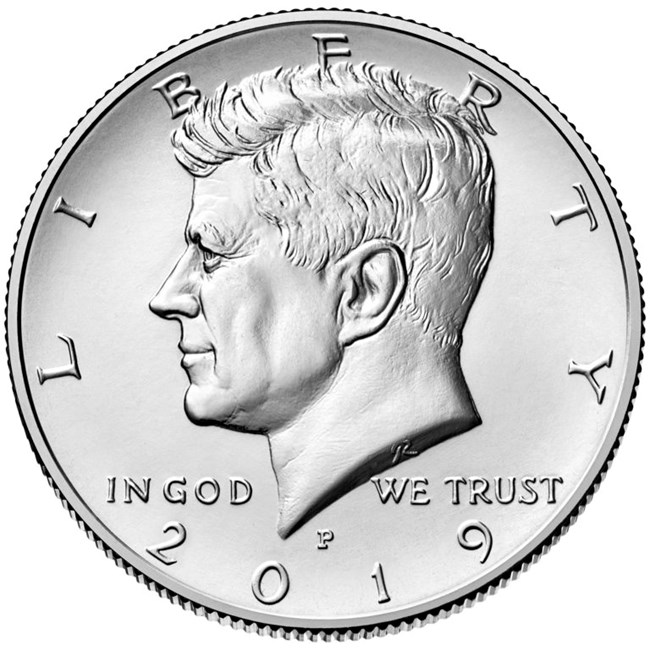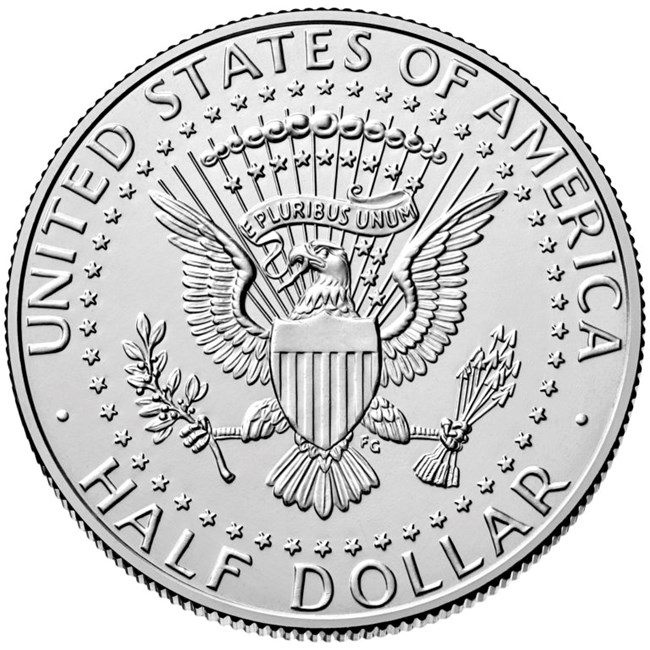Last updated: January 24, 2024
Article
Minting a Legacy: The History of the Kennedy Half Dollar
Within days of President John Fitzgerald Kennedy’s assassination, on November 22, 1963, the U.S. Treasury and U.S. Mint prepared to issue a coin in his memory. Engravers at the Mint quickly completed a new design for the fifty-cent coin featuring the President’s profile on the obverse (heads) side, and the Presidential Seal on the reverse (tails) side. President Johnson signed into law a bill authorizing the design on December 30, 1963. Minting began just weeks later. In the over 50 years since the Kennedy Half Dollar entered circulation, the coin has remained a collectable memento of President Kennedy’s life and legacy.

United States Mint
A Plan in Motion
After President Kennedy’s funeral, discussion began between the Mint, the Treasury, and the Kennedy family to create a new coin in his memory. Several coins in different denominations—the half dollar, quarter, and nickel—were considered. However, Mrs. Jacqueline Kennedy believed the half dollar most appropriate because it would not require replacing another President. At that time, Benjamin Franklin—the famous philosopher, inventor, and revolutionary—was featured on the half dollar coin. On November 27, 1963, Eva Adams, Director of the Mint, telephoned engravers to begin designing a new half dollar coin featuring President Kennedy.

United States Mint
A Design Engraved
The design process relied on the experience and talent of Gilroy Roberts, Chief Engraver at the Mint from 1948 to 1964, to ensure a new design would be ready for immediate minting. “They wanted to start striking the new Half Dollar in January, 1964, only about four weeks away,” remembered Roberts. “This seemed almost an impossibility.” To expedite the process, Roberts and assistant engraver Frank Gasparro modified designs they had completed in 1961 for the John F. Kennedy Presidential Series Medal. Roberts revised his profile sculpture for the obverse (heads) side and Gasparro modified his sculpture of the Presidential Seal for the reverse (tails) side.
Roberts wanted to create a “coin whose beauty would endure and [would leave] no doubt as to the identity of the subject.” On December 13, a series of trial strikes of the new Kennedy Half Dollar was produced at the Philadelphia Mint. Roberts then brought them to Washington for approval by Director Adams, Secretary of the Treasury C. Douglas Dillon, and Jacqueline and Robert Kennedy. All supported the completed design, but Mrs. Kennedy “felt it would be an improvement if the part in the hair was less pronounced.” Roberts incorporated the suggestion into a revised design, which became the basis for the circulated coinage.
A Coin Circulated?
The Treasury first offered Kennedy Half Dollar coins to the public on March 24, 1964, just over four months after President Kennedy’s assassination. That morning, lines stretched outside bank branches across the country as patrons waited to acquire the new coin. Banks had anticipated high demand for the coin and planned to limit purchases to 40 coins per customer. Nonetheless, by noon, customers had depleted the initial supply of 70,000 Kennedy Half Dollars delivered by the Treasury.
Director Adams had initially ordered a striking of 90 million 1964 Kennedy Half Dollars, approximately the same number struck of 1963 Franklin Half Dollars. Recognizing the excess demand for the new coin, the Mint quickly increased its target—first to 140 million, then to 160 million. Nevertheless, Americans continued to collect Kennedy Half Dollars as fast as they could be minted. At year’s end, the Mint received special approval from Congress to continue minting 1964-dated coins into 1965, eventually minting 410 million.
By 1965, the excess minting of the Kennedy Half Dollar had severely depleted the government’s stockpile of silver, which was in short supply around the world. Congress passed the Coinage Act of 1965 which allowed minting silver “clad” coins with copper cores. Beginning with 1965-dated coins, the silver content of Kennedy Half Dollar coins fell from 90% to 40%. As silver prices continued to rise, the use of the metal was eliminated entirely in 1971, except for special commemorative issues.
A Legacy Collected
Since 1964, an estimated 4.1 billion Kennedy Half Dollars have been struck by the Mint, many of which have entered coin collections. During a period of high silver prices in the 1970s, many 1964-dated coins were melted down for their silver.
The design executed by Roberts and Gasparro has changed little during the past 50 years beyond subtle refinements aided by changing technology at the Mint. A special design for the the Kennedy Half Dollar was created to celebrate the United States Bicentennial between 1975 and 1976. The redesigned obverse (heads) side featured a dual date (1776-1976) and the reverse (tails) side a likeness of Independence Hall in Philadelphia.
Recognizing the appeal of the Kennedy Half Dollar principally as a collector’s item, the Mint decreased production of the coin in 2002 to levels that would satisfy collectors’ demands. Today, the coins are only made available to collectors through the Mint and sold at a price above the fifty-cent face value.
To commemorate the 50th anniversary of the Kennedy Half Dollar in 2014, the Mint released a special edition proof coin made of solid gold, as well as several other variations. As in 1964, demand for the new gold coin quickly outstripped supply and the Mint suspended sales at its retail outlets after three days. The continued interest in the Kennedy Half Dollar testifies to the power and durability of President Kennedy’s legacy and the enduring beauty of a coin created to honor him.
